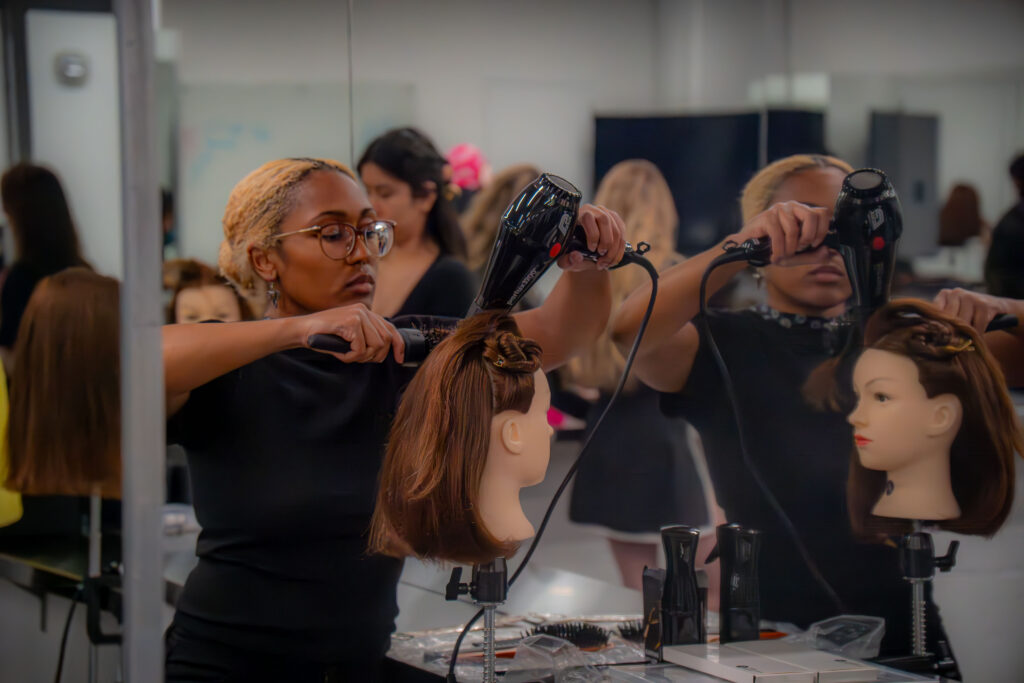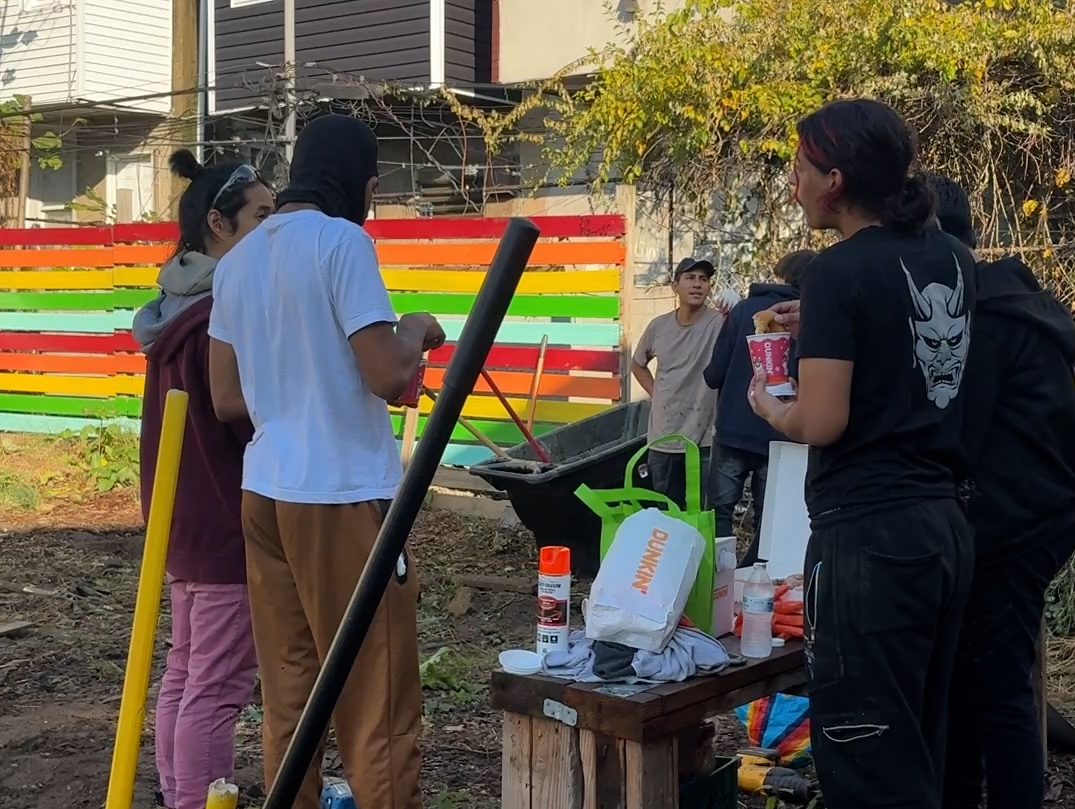NEW YORK — On a busy street in New York City’s stylish Soho neighborhood, you’ll find a tall, narrow two-story building that houses one of the Aveda Arts & Sciences Institutes. The cosmetology school, which also functions as a professional salon, features a variety of textures, from coils and curls to waves and pin-straight hair, on both mannequins and clients. In a large room designed to mimic a real beauty shop, flooded with fluorescent lighting and about 40 mirrored booths, around 15 students murmur amongst themselves in front of a set of mannequins.
In one corner, color director Katie McClusky applies a hair glaze (a temporary color treatment) on a white client’s hair for a campaign shoot for Aveda’s newest hair product. In another, Kortney Rigau, an Aveda instructor for about a year, teaches students how to cut hair short as they anxiously prepare for the arrival of the human model next week. Each classroom at the institute features a diverse range of students studying a styling curriculum that reflects not only their own culture but also others. The program involves two phases: teaching students in a classroom setting for 20 weeks, followed by a clinic on mannequins in the salon space, where students can invite family and friends, and eventually clients.
For those of us with textured hair, it wasn’t always this easy to walk into a salon and expect gold star treatment from any given stylist, leaving many of us to either embrace a perm (a straightener for naturally coarse, kinkier textures) or grab a hot comb to straighten our hair for longer stretches. Some would rather not know what to do with their hair at all.
For many Black women, the search for an inclusive hair salon has been a struggle since childhood. Two years ago, New York City took a major step to change that. In April 2023, New York State Senator Jamaal T. Bailey introduced a bill requiring the Cosmetology State Board’s licensing to include training and testing on textured hair. Assemblywoman Michaelle C. Solages then carried the bill. On Nov. 17, 2023, Governor Kathy Hochul signed Bill S6528A into law. Schools were given six months to incorporate it into their programs.
Now, in the wake of the bill’s second anniversary, the question is: Has the law made a difference?
It’s no secret that textured hair training has been historically, systematically excluded from cosmetology education. For decades, many Black women with textured hair had to make do with limited knowledge about their hair, even without a stylist. Hair professionals were, meanwhile, considered professionals without knowing how to do textured hair, leaving some hairstylists to either teach themselves or remain unprepared.
From curly hair routines to “product favorites” videos, the explosion of the natural hair movement in the 2010s, particularly on YouTube, created a safe space for those with textured hair to learn about their textures, patterns, and styles from curly girl content creators. When asked how Aveda’s students tend to react to textured hair at first, Traci Sakosits, the Vice President of Education and Creation at Aveda Arts, emphasizes that some of them come in well-equipped and know more than some team members
“Because they grew up culturally doing textured hair,” Sakosits explains.
“Growing up in the ’80s and ’90s, aside from a protective style, a lot of women were wearing their hair straight,” says hairstylist Tatum Neill, Aveda’s artistic director of social media, who is white. “Unless you face hair discrimination, you may not know about it. The market has shifted, and it’s been accelerated by social media. That’s great because more people are exposed to it.”
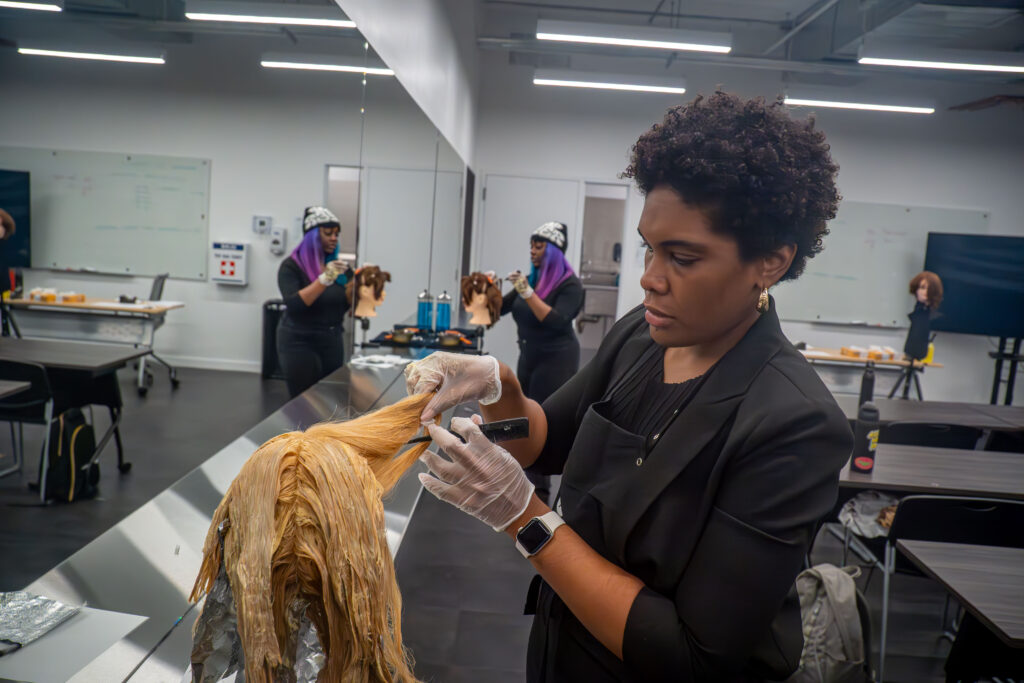
A student at the Aveda Arts and Sciences Institute works on coloring hair in a class. [Photo Credit: Lynise Olivacce]
Speaking via Zoom, Neill, an Aveda Arts alumnus since 2006, says those teachings felt ingrained in students during his stint. “Texture education felt totally normal and appropriate. It didn’t feel like an abstract idea,” he says. “Part of it was that our student body needs to have representation within the hair space. And so, how do we make sure we’re addressing the needs and desires of all of our students?”
In the past few decades, the beauty industry drastically widened its scope to include more textured hair in the curriculum. Now, hairstylists of all types hope that, with the introduction of Governor Hochul’s bill, more predominantly white salons will begin to look more like melting pots. Some are optimistic. Others wonder how long it’ll take for systemic change to take shape.
In recent years, the tri-State area experienced a surge in textured hair salons and cosmetology schools, from Rëzo Curl to Ouidad salons and the Brooklyn-based Magic Fingers Institute.. The Magic Fingers Institute, founded in 2015, dedicates its entire hair curriculum to natural hair, whether it’s two-strand twists or protective styles.
Both Neill and McClusky believe the city’s 1,000-hour requirement for cosmetology students to graduate is insufficient. They encourage their students to be forever learners once they graduate and go out into the real world in professional salons or apprenticeships.
Tiffany Abrams, a Black woman who has grown up with thick “Type 4” hair (the tightest curl pattern), stresses how important it is for cosmetology schools to incorporate natural, textured hair in their curriculum.
“Especially as a person who has grown up getting perms, figuring out how to do the best sew-in,” she says. “Even though steps have been made to show the importance of textured hair in cosmetology schools, I still see a lack.”
She adds that professional readiness is especially important in multicultural cities. “We should expect stylists to be competent with all hair types,” she says. “Not learning textured hair puts graduates at a disadvantage.”
The beauty industry at large now better understands the needs of textured hair. For example, the fact that curly hair loves water and that it’s best to work the hair in sections. But this context is still missing in many areas. Atlanta-based curly hair specialist and TikToker, Didi Edwards, had zero education on natural hair in cosmetology school and had to teach herself.
“We get a giant textbook that tells us everything we need to know to pass the state board exam,” she says [in a TikTok video posted in March]. “None of it has anything to do with how to take care of natural hair. And if a cosmetology school wants to educate on natural hair, they have to order additional materials [which are small]. If they want to make sure they want to serve all clients, no matter who is sitting in the chair, they can care for them. I’ve taken several certification courses so that I truly understand the nature of all types of curls and coils.”
Aveda started out as a distributor, selling shampoo to salons. The well-known Australian hairdresser, Horst Rechelbacher, founded the company in 1978. The following year, he partnered with Edwin Neill (Tatum’s father), who loved the company’s mission to make plant-based products. In the 1990s, Aveda expanded into operating its own salons. The first Aveda Arts & Sciences Institute popped up in Minneapolis, and now the institute operates in New York and other major cities like Los Angeles, Dallas, and Atlanta. They teach students both cosmetology and esthiology and are known for a hands-on approach to learning.
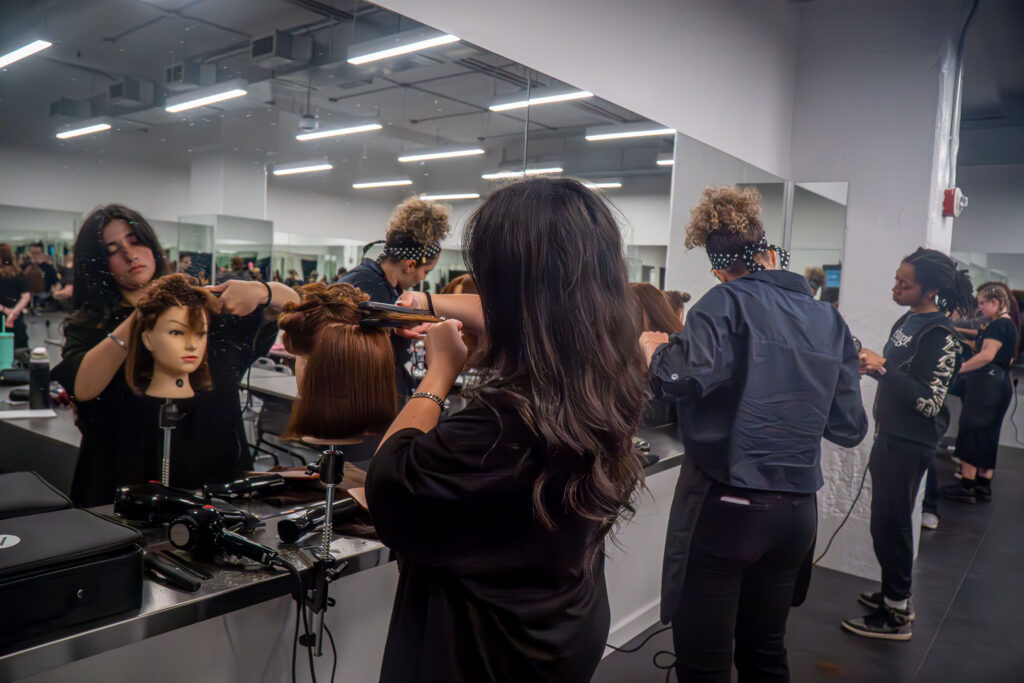
Students work on mannequins in a hair coloring class. [Photo Credit: Lynise Olivacce]
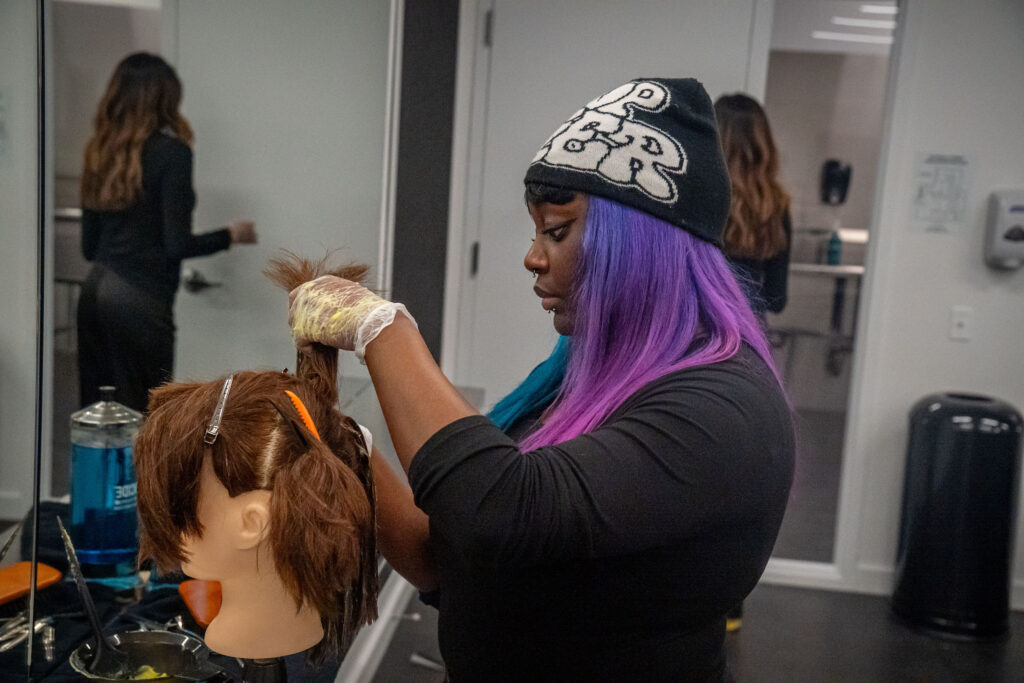
A student works on a mannequin in a hair coloring class at Aveda. [Photo Credit: Lynise Olivacce]
April Little has been a student at Aveda Arts for ten months. Before she enrolled, she knew little about the basics of working with textured hair.
“It’s been great being here and having the experience of multicultural clients and students,” she says, standing at her hair station in the space resembling a salon. She’s practicing what’s called Hollywood waves on a blonde mannequin—a glamorous vintage hairstyle with uniform S-curl waves. “I learned a lot from the instructors, my fellow students, and the clients themselves,” she says. “Like, how do you take care of your hair and learn what works best for different people?”
Educators like Sakosits believe this kind of exposure is key to building well-rounded professionals. Since the bill passed, Aveda’s curriculum, like hair, is always growing and incorporating new things that help normalize textured hair and make it less of a specialty.
Sakosits first introduced the idea of using mannequins with multiple textures because, as she says, it’s “extremely unusual” for an individual’s hair to be just one texture. “It is more expensive,” she says. “But if it gets us closer to a more inclusive curriculum, that’s what you gotta do.”
Black girls with textured hair long struggled to find the secret to a super-defined curl or the perfect sew-in weave. According to Wonder, women spend about $80 per month on hair products and treatments, making the lifetime spending about $55,000. The average curly hair consumer tries between six to 20 different products before finding ones that work well for their hair type. Black women reported using five or more hair care products daily at home.
For salons that haven’t caught up with the bill, it’s a missed opportunity, considering the future of the industry. “Why close yourself off to 65 percent of the market?” says Neill. “As an artist, as a creative, as a haircutter, it’s fun to create shapes, you know. That’s what drew me into texture.”
Tierra Syndor, a 24-year-old Bronx resident and New York University student, is a self-taught hair braider. She applauds the fact that texture education is now a requirement in New York cosmetology schools, compared to years ago. “Back then, unless you had Black instructors, you weren’t learning how to do textured hair,” she says. “Beauty schools need to advocate and say, ‘Hey, in this shop, we need to learn this.”
In Hackensack, N.J., Brianna McKinley, a Black woman in medical administration, likewise believes cosmetology schools that don’t adapt the curriculum are doomed to be left behind. “Just like technology evolves, [cosmetology schools] need to evolve, because if you don’t, you’re gonna die out,” she says. “If you don’t learn, then you’re gonna be the only person on earth not to know anything, and everybody else is going to be in a whole technical world.”
